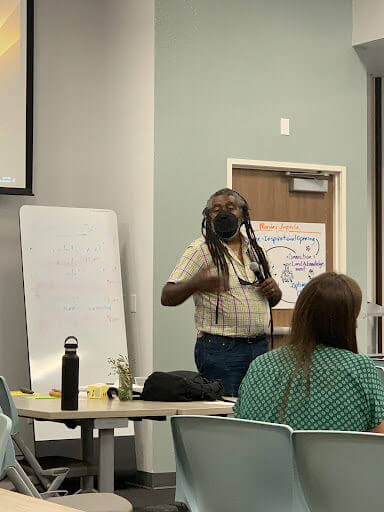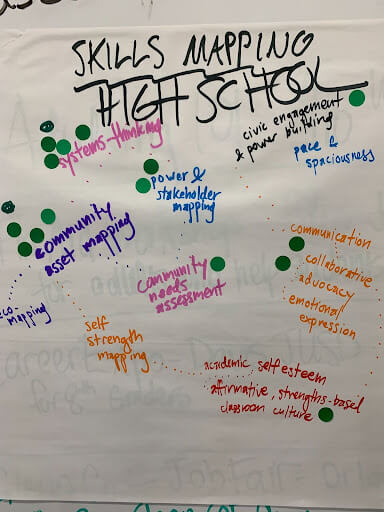Earlier this summer, Ten Strands convened the community- and student-centered organizations selected to create curricular resources that will help teachers increase their students’ understanding of climate change and environmental justice, leading to impactful action in their communities as part of the Climate Change and Environmental Justice Program (CCEJP). The units will be designed to provide community-centered and culturally responsive learning experiences and will be available for free as open education resources to all educators in California.
Designing this innovative curricula to support student learning and action requires knowledge of California state content standards and Environmental Principles and Concepts, climate change science, environmental justice principles, and effective pedagogy, as well as collaboration, community, and collective action. Working with nationally recognized Biological Sciences Curriculum Study (BSCS) Science Learning, the Ten Strands team kicked off CCEJP by designing three intense days of collaborative work to build a learning community, understand the California context, and establish the unit and lesson design goals across grade levels. Through California’s $6 million investment to create environmental curricular resources, Ten Strands was able to assemble a unique combination of local, state, and national organizations to lay the foundation to create learning opportunities to address climate change and environmental justice in diverse communities across California.
The writing teams selected for this program bring combined expertise in climate science, community-centered project-based learning, curriculum design, environmental education, environmental justice, open education resources, professional learning, and traditional ecological knowledge. Activities at the convening were designed to build on the range of experiences and expertise in the room and engage participants in discussions to set community agreements, create a common understanding of environmental justice, and share strategies to ensure the cross-discipline curricula developed are student-centered and place-based.
“The agenda was so thoughtfully designed and was inclusive of multiple learning styles, dove deeply into certain areas, but still allowed for important pivots, as the group needed,” said Alexa Norstad from the Center for Ecoliteracy. “It was intense and intensive, but welcome, and we left with clarity about the work ahead.”
Another participant reported feeling respected, encouraged, and supported in the processes to develop relationships and draw on the knowledge of those in the room.
Each day, the facilitators solicited input from the participants to refine and enhance the agenda. This feedback highlighted the need for more time to have critical conversations about environmental justice, equity, and inclusion.
Milton Reynolds, a member of the CCEJP Steering Committee, led a discussion with the writing teams and supported them in their design of the curricula to ensure they were centered in environmental justice, student action, and empowerment. Reynolds is also a California-based career educator, author, equity and inclusion consultant specializing in supporting groups to understand environmental justice, youth development, educational transformation, and disability justice.
Writing teams were organized into grade-level bands (elementary, middle, and high school) to understand organizational strengths, share strategies, and identify common frameworks for unit and lesson design.
The writing teams for elementary-level curricula did a deep dive into what it would look like to center diverse student and community experiences, as well as data to learn about climate change across multiple disciplines, including science, social studies, art, and health.
The middle school team also generated ideas about what it means to create student-centered, place-based learning that brings joy and hope as students engage in rigorous interdisciplinary study.
Finally, the high school grade-level band mapped the skills students might master as part of these units. One participant expressed appreciation for the time spent in grade bands and getting to know the organizations we will be in collaboration with on this program.
By engaging in an inquiry-based approach, students and teachers will have opportunities to make observations and ask questions in order to develop deeper understandings about climate change and environmental justice issues that will lead them to take meaningful action in their own communities. As part of this inquiry process, they will create models to bring their expertise to life, allowing them to explore scientific and social phenomena. During the convening, curriculum writing teams experienced online tools from Concord Consortium that will allow students to generate models and analyze data. Tools likeSageModeler and CODAP are powerful strategies to help students design, test, and refine their thinking.
Our August convening created engaging and exciting ways for teams to innovate and collaborate. The program planning and design has continued over the last several months. Engaging in team meetings, design and sharing sessions, and asynchronous learning, the writing teams are working toward piloting initial lesson plans in the spring of 2023. Stay tuned in the coming months as we feature stories written by each of the writing teams that will highlight their work and their diverse perspectives around the importance of environmental literacy.




